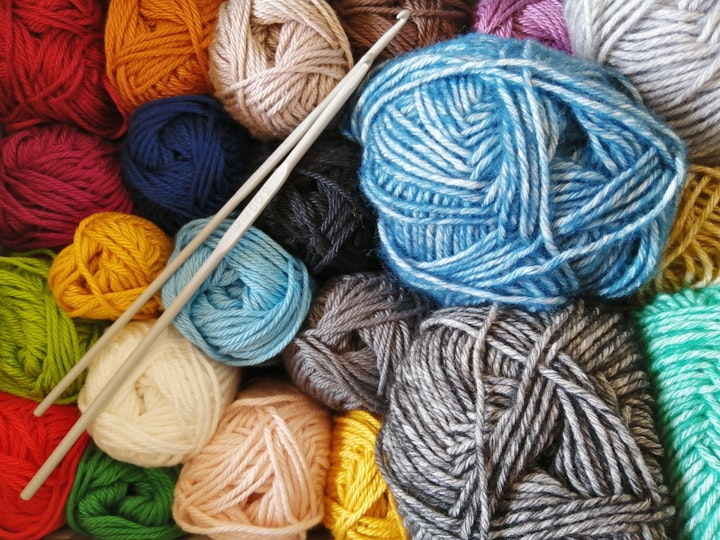Arts 'n' Crafts Therapy
Learn about the top 5 benefits of knitting for people with mental illness and addictions

History of Knitting
Knitting is a form of textile art that people practice to create particular pieces of garment, home decor, and accessories. Knitting can be done manually by a pair or needles, a loom and hook, or electronically with the use of a machine.
Knitting is in fact, one of the most primitive fashion design methods that has been utilized since 5th century AD. Knitting had first originated in the Middle East, and early knitters were from Egypt. Many of the knitted products were made from cotton fibres, as opposed to traditional wool. As a symbol to stave off bad luck, Arabic blessings have been knitted into the products that were made.
During the 14th century, knitted textiles were used by fishermen to create warm, woollen waterproof jumpers for excursions to the sea. And then in the 16th century, knitting machines were invented to knit hosiery for elite classes.
Soon after, knitting became a common form of fashion design in the Highlands and Scotland. Males became employed factory workers, in which they were hired to knit stockings to be exported to the rest of Europe. Other pieces of garment and accessories like hats, scarves, bags, and jumpers were knitted and became available in the market. The first knitting loom was built in 1816. Woollen mills were installed to make pricey clothes.
In the 20th century, knitting became a part of mainstream fashion that was practical, modern, trendy and was able to cater to all genders. Popular fashion labels such as Chanel also sold knitted clothes.
Health Benefits of Knitting for People with Mental Illness and Addictions
Just like engaging in therapeutic activities like horseback riding, pilates, aquatherapy, and pet therapy, knitting can be one of those creative activities that can have a positive impact on people with medical conditions, mental health disorders, and addictions. Visual arts is one of the most effective ways for people to heal and cope with their health challenges, while certain forms of visual arts have similar advantages to painting or mandala making. There are several health advantages of knitting for people with various illnesses and disorders such as:
1. Helping to alleviate chronic pain
Chronic illnesses negatively affect people across the globe. Regardless of age, gender, race, ethnic background, and ability, everyone is struggling with at least one health issue in their life. While most people experience shorter term illnesses/injuries like broken limbs, the flu, the common cold, and/or cuts, a smaller portion of the population struggles with at least one chronic illness.
Many creative activities that enable the individual to unplug and take a break becomes an integral part of pain management. Knitting is an example of one of the creative pastimes that people often pursue as a mean to manage their chronic pain. It provides physical, emotional, mental and social support for individuals from all walks of life. This is especially the case for people with chronic illnesses.
2. Providing social support
Being your own best friend is crucial for our personal mental health. As much as alone time is needed for us to function properly, having some level of social interaction is vital for the mental, psychological, social, and emotional support of humans.
When people gather with friends and family, they often like to take part in some form of pleasurable activity, which can mean various things for various people. The most common kinds of leisure activities are playing tabletop games, knitting, crocheting, cooking, walking, and dancing. Knitting does not have to be done by one person. Avid knitters of all levels can mingle and build friendships with other knitters in multiple settings like at a knitting club in a community centre.
3. Helps to reduce anxiety
According to research, people who knit on a regular basis are less prone to anxiety, as opposed to people who don't knit on a regular basis. Knitting has a measurable effect on alleviating anxiety. Based on an international survey, a strong relationship between knitting and a sense of relaxation allows people to experience more positive emotions such as happiness and joy. This is because, kntting enhances levels of serotonin which is a hormone that is responsible for regulating mood, sleep, and increasing the ability to retain information. Low levels of serotonin make people susceptible to mood disorders like depression and anxiety.
For others who don't necessarily have clinical anxiety but rather deal with chronic stress, knitting can be extremely beneficial for those people, as knitting also reduces stress levels in humans. People who deal with anxiety and stress on a regular basis are at risk of multiple complications such as high blood pressure, increased alienation, and resort to unhealthy coping mechanisms like drug use. Knitting can help people cope with their stress in healthy ways, lower their blood pressure, distract them from chronic anguish, as well as lower their stress levels which are all be components of being healthy in the long-term.
4. Increased self-esteem
Life can be challenging for people living with mental health disorders, addictions, and/or chronic diseases. Depending on the individual, choices for recreation participations and/or pursuits can be compromised, due to some of the limitations that make recreation participation more challenging for that specific person. However, that doesn't mean that this is the reason for all people who experience mental health disorders, addictions, and/or chronic diseases.
Some people who are living with disabilities can't obtain a job or volunteer, so they need to fill their days with meaningful, creative, intellectual, and stimulating activities. For individuals that have limited access to recreation programs, or have limited recreation options, there are at least a few things that keep their minds and bodies occupied. Pursuing any type of hobby can increase self-esteem in a person, regardless of the nature of hobby.
If a person has the physical capacity to use knitting needles and/or equipment, knitting can be a perfect self-esteem booster. When you are creating something like a blanket, a bag, or a scarf for yourself, it can save you money on store-bought items, the opportunity to wear a homemade piece of garment, as well as giving you a sense of accomplishment. If you are making pieces of garment or accessories as a gift for your friends and family, this can give you the best opportunity to save money on birthday and/or Christmas presents. Instead of spending $200.00 on clothes, electronics, or antiques, a few of your gifts can be homemade.
5. A great way to take a time out
Nowadays, people aren't pursuing many manual hobbies like knitting, crocheting, or playing an instrument. In lieu or meaningful hobbies that aare beneficial for the mind, body and soul, the majority of people spend hours on social media, various phone apps, and playing video games. Although a moderate level of social media, video gaming and phone usage is reasonable for social, employment, and leisure purposes, excessive use is detrimental to the social and mental wellbeing of people. This is particularly the case for teenagers who are active users of social media platforms such as TikTok and Snapchat.
As opposed to spending 4 hours of your free time on social media or on your phone, it can be worthwhile to practice a hobby that can benefit the social, mental, physical, and emotional health of people. Knitting is a great replacement to long hours of phone usage. While you're watching your favourite show, talking to a friend, sitting in your backyard, resting in your bedroom, or retreating to your living rooms after a long day, you can grab some needles and yarn to begin or continue a knitting project!
How to Get Started
It's never too late to start a new hobby! For hobbies such as knitting, there are multiple ways to get started. Many specialty, dollar and department stores sell knitting needles, looms, machines, and yarn for knitters of all levels to purchase for regular use. If you want to spend less money on knitting supplies, department and dollar stores would be your best bet! At specialty stores like Michaels, the products can be pretty pricey. Depending on where you reside across the glove, the stores that I would recommend to knitters of all levels are Michaels, Walmart, Dollar Tree, and DeSerres. You can also do your own research on stores that are in your country and buy knitting supplies from there.
For people that are eager to learn to knit but don't merely want to learn independently, attending knitting classes/clubs can be an advantage. This is a smart alternative for social people, auditory learners, as well as people that prefer group learning over independent learning. In addition to attending knitting clubs/classes at your local community centre or art studio, joining online knitting clubs and communities are also good. If you don't want to spend money on classes/clubs, watching free YouTube tutorials are also possible, as well as downloading or purchasing pattern books for you to read and follow along to. Following knitters on Instagram can give you further ideas on projects, products, and inspiration to knit.
If you are only a beginner, you're better off starting small and simple. Knitting things like scarfs, potholders, and blankets are perfect for beginners. You can work your way up to bigger, better and more complex projects once you get better!
Selling your Knitted Products
For people that don't have a job in a business setting and want to start their own small business, selling your knitted products is a perfect way to keep yourselves busy! Some people who are living with mental health issues often have a challenging time finding meaningful and suitable employment in their communities. As a result, they like to work by launching their own small businesses in which they sell their handmade art pieces, or handcrafted products like jewellery, knitted garments, and DIY bath products. It gives them the opportunity to work in their comfort of home, while giving them the chance to make money and live a meaningful life. Websites and platforms in which you can sell your knitted products online include Etsy, Red Bubble, Facebook, Instagram, and Kijiji.
If you prefer working in the community as opposed to online, places such as flea markets, craft fairs, and garage sales are other possible ways to sell your knitted products for profit.
Donating them to stores like Value Village can also be a good option for people that don't really want to earn money, but want to donate them to a thrift store, so people can purchase them for low prices.
Bottom Line
All forms of art can be practiced by everyone, not just people who suffer from chronic health conditions, or are living with disabilities. For people that can't afford to buy nice clothes, knitting is a perfect option to make clothes, accessories, and other things for yourselves and your families to treasure, wear, and keep in the house.
Some people prefer to have their own businesses, in which they can sell their handcrafted products. What is great about our generation is that, there are multiple online platforms in which you can easily make money by selling, as opposed to working in a merchant's market or craft fair, if you don't like mingling with too many people, or standing for long hours. Even if you make very little money, you are still making a meaningful contribution to your communities.
References
https://knitom.com/therapeutic-knitting/
https://mhanational.org/blog/mental-health-benefits-knitting
About the Creator
Talia Devora
Poetess, visual artist and lifestyle/quiz writer! My pastimes include reading, sleeping, gaming, music, fitness, etc! Be yourselves, be kind and value life! Let's connect and be friends!
My IG accounts: @tdwrites24 & @tdcreates97






Comments
There are no comments for this story
Be the first to respond and start the conversation.